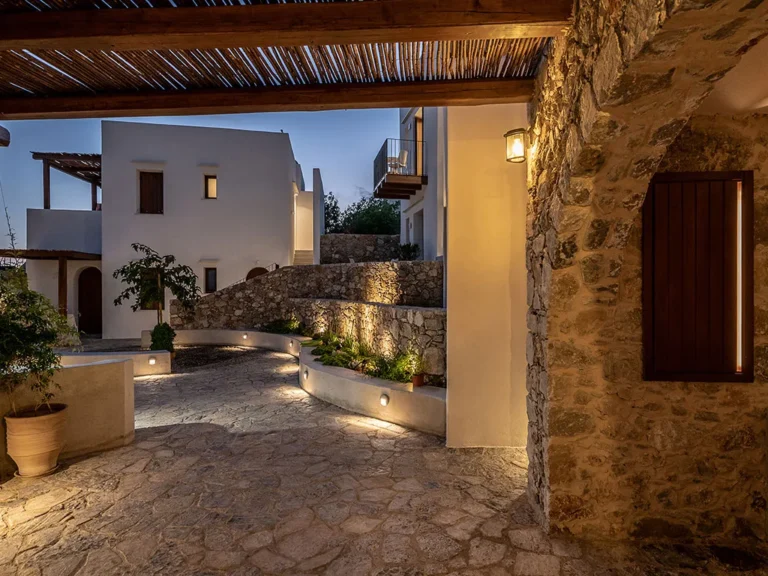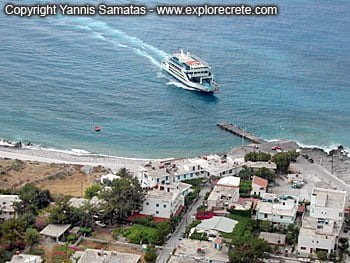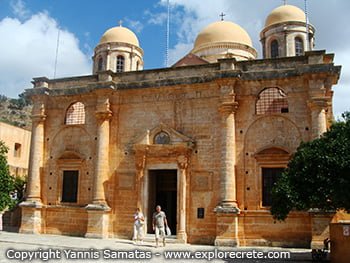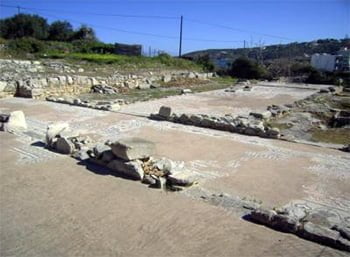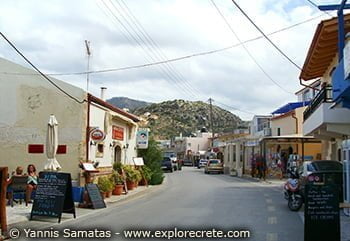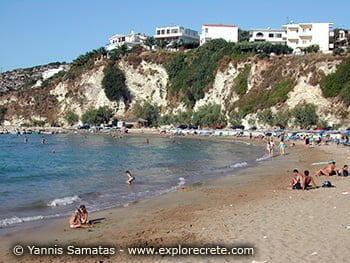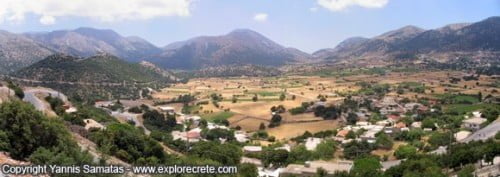Hora Sfakion or Sfakia
Sfakia, Hora Sfakion or Chora Sfakion
Hora Sfakion or Sfakia is a small, historical town of fewer than 500 inhabitants, on the south coast of Chania Prefecture.

Hora Sfakion (also Chora Sfakion) is the capital of Sfakia Municipality, in the area also known as Sfakia, which includes the most mountainous district in the wider Chania area.
Sfakia Municipality is the most sparsely-populated municipality in Greece, with 2,484 inhabitants in an area of 468 square kilometres. It comprises the villages of Hora Sfakion, Anopoli, Agios Ioannis, Agia Roumeli, Asfendou, Frangokastello, Loutro, Patsianos, Skaloti, Imbros and Askifou.
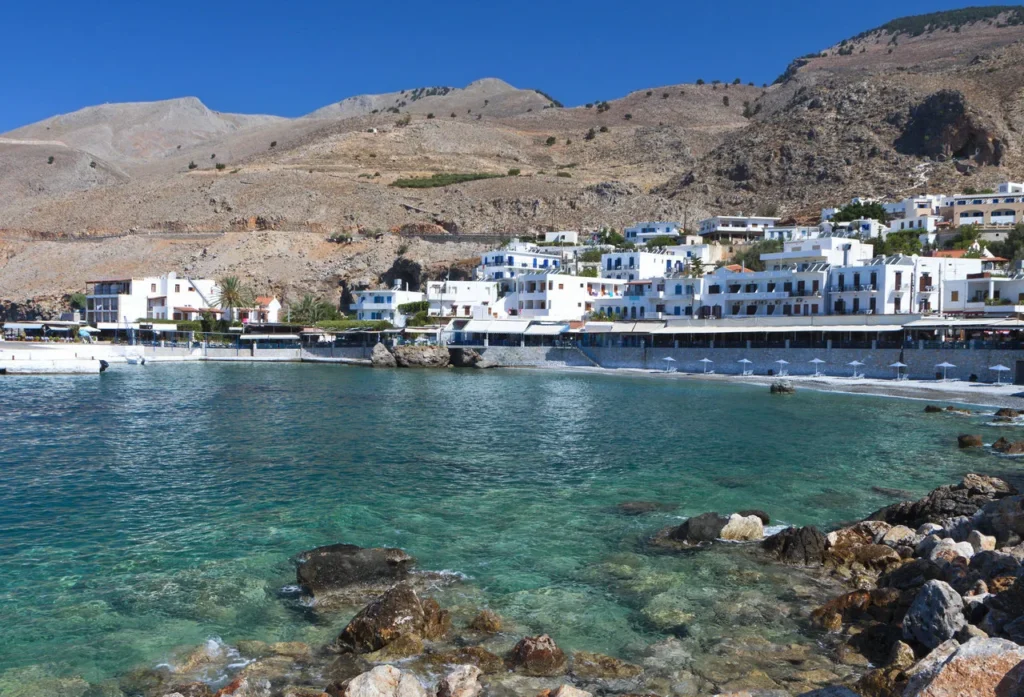
The whole of Sfakia has the natural beauty of a wild mountain landscape, forming a unique combination with the sea nearby. Sfakia includes most of the White Mountains, also known as Madares, with Pachnes, the highest peak in the range (2454 m). It also comprises the Samaria Gorge, one of the most popular sights in Crete. Other gorges in Sfakia are those of Klados, Domata, Elygias, Aradaina, Sfakiano, Imbros, Asfendou and Kallikratis.
Origin of the name Sfakia
There are three different explanations for the name Sfakia – but we don’t know which one is true.
- Sfakia means “land of the gorges”, from the word “sfax”, meaning a chasm – eminently suited to Sfakia with its many deep gorges.
- Sfakia is named after the oleander tree, called a “sfaka” in the Cretan dialect. There is also the expression “it’s sfaka”, meaning that something is very bitter.
- The third version has it that Hora Sfakion was originally called Sfikia but the name was later corrupted to Sfakia.
How to get to Hora Sfakion
Hora Sfakion is 74 kilometres south of Chania. To get there from northern Crete, you have to pass through Vrisses, the village of flowing streams, barbecues and delicious yoghurt and honey. From this point onwards the road runs up and up to the Askifou Plateau and Imbros, where the descent to the south coast and Hora Sfakion begins.
Drive alongside the deep Imbros Gorge for a while, and sometime later you will see the endless blue of the southern sea of Crete, the Libyan Sea, stretching as far as the eye can see. The islands visible in the distance on a clear day are Gavdos and Gavdopoula, the southernmost islands of Europe.
The road from Imbros to Hora Sfakion is the most difficult, but also the most beautiful part of the journey. All around are wild mountains (the White Mountains or Madares) and deep gorges (Imbros Gorge to the east and Sfakiano Gorge to the west), with the road twisting like a snake along the edge of the cliff, and the sweet promise of the beach and the blue sea awaiting you at the end of the journey.
We are in the heart of Sfakia, and a different wind seems to blow here. It brings the coolth of the high peaks, the scent of pine and thyme, the sound of the goat bells, and above all, the stories of the proud Sfakians who have never surrendered to conquerors, who defied death and led countless revolts against the Turks. It is a wind full of pride, love and awe. Pride in the history of this land, love for the Cretan homeland, awe at the untamed beauty which makes the heart swell and a smile spread across one’s face.
Stop for a while at the edge of the cliff and let your senses embrace Sfakia. You are high up and your gaze can fly like an eagle from Loutro in the west to Frangokastello in the east and Gavdos in the south. Get your fill of the amazing view before continuing down to Hora Sfakion.
Chora Sfakion today
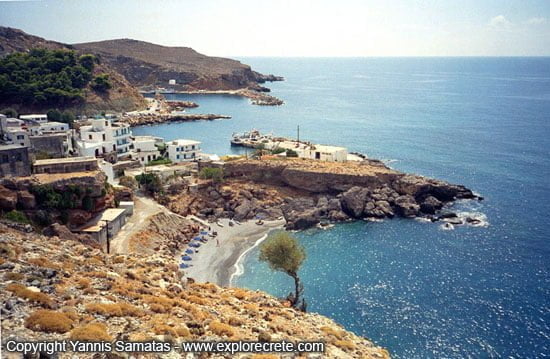
Fifteen minutes later you come to the first houses in the upper neighbourhood of Hora Sfakion. Here are a few trees and the ruins of the Venetian fortress of Sfakia or Sfachia, the Venetian commander’s residence, which was later repaired by the Turks. There is a great view of the whole of Hora Sfakion from above.
The road runs down to the parking area. In summer it will be full of tourist coaches coming to pick up the people who cross the Samaria Gorge and come to Hora Sfakion by ferry from Agia Roumeli. There are also boat trips from Hora Sfakion to Loutro, Paleochora and Gavdos. There are many daily trips in summer but much fewer in winter.
Leave your car here and walk along the coast road with its restaurants. There are lots of restaurants next door to one another, ever ready to serve the thousands of tourists arriving or leaving on the ANENDYK ferries. This is the old, small harbour of Hora Sfakion, recently replaced by a larger one to the east.
If you have time, leave the coast road and explore the village alleyways. Here the picture changes and the past comes to life in the single- or two-storey buildings with their inner courtyards, beautiful doors with carved stone archways and paved streets.
If you decide to stay in Hora Sfakion, there are rooms for rent and a few small hotels. Just outside Sfakia to the east is the Vritomartis Naturist Hotel, an official nudist resort.
Hora Sfakion has only basic amenities: a petrol station, a post office, an OTE telecommunications office, a chemist’s, a police station and cashpoint machines. There are also taxis and a daily bus service to Chania.
Hora Sfakion Beaches
- There is a beach in the small harbour, but you’re better off going to the western beach at the exit of the village (photo above)
- Another choice is Iligas Beach, about one kilometre west of Sfakia, with rooms for rent and a taverna. There you will find many sea caves along the shore.
What to do in Hora Sfakion
If you are staying in Hora Sfakion you can use it as a base for exploring the area. The Sfakia district has much to offer both beach-lovers and sports enthusiasts. There are wonderful paths for hiking and high peaks for climbing.
At the seaside you can enjoy fishing, scuba diving and of course swimming in the crystal-clear waters of the Libyan Sea.
- Detailed info about sightseeing and activities in Sfakia area
© explorecrete.com All Rights Reserved. Reproduction or copying without permission is prohibited.

